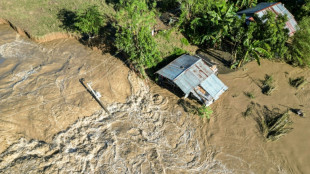
-
 Taxing the richest: what the G20 decided
Taxing the richest: what the G20 decided
-
'Minecraft' to come to life in UK and US under theme park deal

-
 IMF, Ukraine, reach agreement on $1.1 bn loan disbursement
IMF, Ukraine, reach agreement on $1.1 bn loan disbursement
-
Japan on cusp of World Cup as Son scores in Palestine draw

-
 Chelsea condemn 'hateful' homophobic abuse towards Kerr, Mewis
Chelsea condemn 'hateful' homophobic abuse towards Kerr, Mewis
-
Hamilton to race final three grands prix of Mercedes career

-
 Gatland has not become a 'bad coach' says Springboks' Erasmus
Gatland has not become a 'bad coach' says Springboks' Erasmus
-
Slovakia take Britain to doubles decider in BJK Cup semis

-
 Brazil arrests soldiers over alleged 2022 Lula assassination plot
Brazil arrests soldiers over alleged 2022 Lula assassination plot
-
Ukraine war and climate stalemate loom over G20 summit

-
 Ukraine fires first US long-range missiles into Russia
Ukraine fires first US long-range missiles into Russia
-
Retiring Nadal to play singles for Spain against Netherlands in Davis Cup

-
 Rain ruins Sri Lanka's final ODI against New Zealand
Rain ruins Sri Lanka's final ODI against New Zealand
-
Stocks sink on fears of Ukraine-Russia escalation

-
 Hendrikse brothers start for South Africa against Wales
Hendrikse brothers start for South Africa against Wales
-
Macron tells Xi he shares desire for 'durable peace' in Ukraine

-
 Ruthless Japan beat China to move to brink of World Cup qualification
Ruthless Japan beat China to move to brink of World Cup qualification
-
French farmers threaten 'chaos' over proposed EU-Mercosur deal

-
 Brazil arrests G20 guards over alleged 2022 Lula assassination plot
Brazil arrests G20 guards over alleged 2022 Lula assassination plot
-
China's Xi urges 'strategic' ties in talks with Germany's Scholz

-
 Raducanu gives Britain lead on Slovakia in BJK Cup semis
Raducanu gives Britain lead on Slovakia in BJK Cup semis
-
Russia says Ukraine fired first US-long range missiles

-
 COP29 negotiators strive for deal after G20 'marching orders'
COP29 negotiators strive for deal after G20 'marching orders'
-
Walmart lifts full-year forecast after strong Q3

-
 British farmers protest in London over inheritance tax change
British farmers protest in London over inheritance tax change
-
NATO holds large Arctic exercises in Russia's backyard

-
 Trouble brews in India's Manipur state
Trouble brews in India's Manipur state
-
Son of Norwegian princess arrested on suspicion of rape

-
 Romanian court says 'irregularities' in influencer Andrew Tate's indictment
Romanian court says 'irregularities' in influencer Andrew Tate's indictment
-
Iran faces fresh censure over lack of cooperation at UN nuclear meeting

-
 Despondency and defiance as 45 Hong Kong campaigners jailed
Despondency and defiance as 45 Hong Kong campaigners jailed
-
Scholar, lawmakers and journalist among Hong Kongers jailed

-
 European stocks slide on fears of Russia-Ukraine escalation
European stocks slide on fears of Russia-Ukraine escalation
-
Police break up Georgia vote protest as president mounts court challenge

-
 Spain royals visit flood epicentre after chaotic trip
Spain royals visit flood epicentre after chaotic trip
-
France's Gisele Pelicot says 'macho' society must change attitude on rape

-
 G20 leaders talk climate, wars -- and brace for Trump's return
G20 leaders talk climate, wars -- and brace for Trump's return
-
US lawmaker accuses Azerbaijan in near 'assault' at COP29

-
 Tuchel's England have 'tools' to win World Cup, says Carsley
Tuchel's England have 'tools' to win World Cup, says Carsley
-
Federer hails 'historic' Nadal ahead of imminent retirement

-
 Ukraine vows no surrender, Kremlin issues nuke threat on 1,000th day of war
Ukraine vows no surrender, Kremlin issues nuke threat on 1,000th day of war
-
Novo Nordisk's obesity drug Wegovy goes on sale in China

-
 Spain royals to visit flood epicentre after chaotic trip: media
Spain royals to visit flood epicentre after chaotic trip: media
-
French farmers step up protests against EU-Mercosur deal

-
 Rose says Europe Ryder Cup stars play 'for the badge' not money
Rose says Europe Ryder Cup stars play 'for the badge' not money
-
Negotiators seek to break COP29 impasse after G20 'marching orders'

-
 Burst dike leaves Filipino farmers under water
Burst dike leaves Filipino farmers under water
-
Markets rally after US bounce as Nvidia comes into focus

-
 Crisis-hit Thyssenkrupp books another hefty annual loss
Crisis-hit Thyssenkrupp books another hefty annual loss
-
US envoy in Lebanon for talks on halting Israel-Hezbollah war

| RBGPF | -0.74% | 59.75 | $ | |
| RYCEF | -2.54% | 6.68 | $ | |
| RIO | 0.23% | 62.266 | $ | |
| BCC | -1.85% | 138.965 | $ | |
| RELX | 0.46% | 45.25 | $ | |
| SCS | -1.13% | 13.052 | $ | |
| VOD | -0.06% | 8.915 | $ | |
| CMSC | -0.02% | 24.62 | $ | |
| CMSD | -0.08% | 24.371 | $ | |
| BCE | 0.65% | 27.408 | $ | |
| BTI | 0.42% | 36.835 | $ | |
| AZN | 0.92% | 63.98 | $ | |
| BP | -1.4% | 29.015 | $ | |
| NGG | 0.91% | 63.48 | $ | |
| GSK | -0.78% | 33.43 | $ | |
| JRI | -0.23% | 13.2 | $ |

Ukraine eyes Romanian port for key farm exports
Faced with a Russian blockade of its own ports, Ukraine is seeking to export the farm goods that many countries depend on via the Romanian Black Sea port of Constanta.
The solution is crucial both to Ukraine's economy and to entire populations that rely heavily on its wheat and sunflower oil.
Bucharest has confirmed that discussions are underway with Kyiv, pointing out that Constanta already handles some imports to Ukraine and exports from it.
Before the war, Ukraine accounted for 12 percent of global wheat exports, 15 percent of maize and 50 percent of world sunflower oil.
"We and our partners are looking for alternative logistical routes to export our goods via European ports, including Constanta," Ukrainian Agricultre Minister Mykola Solsky said recently.
- Ukraine ports blockaded -
The presence of Russian battleships and mines in Ukrainian waters renders commercial shipping there nearly impossible.
Since the start of the war, Russian forces have been blocking access to the southeastern Ukrainian ports of Berdiansk and Mariupol on the Sea of Azov, which opens into the Black Sea.
In the southwest, the crucial Black Sea port of Odessa lies perilously close to the frontline at Mykolaiv.
Odessa handles 90 million tonnes of shipments a year -- 60 percent of the country's total port traffic -- and is in the Krelmin's sights.
The Marine Traffic website, which tracks the position of all seagoing vessels, clearly shows the de facto blockade of these waters.
Commercial ships have been absent from the zone since missile attacks on vessels sent their insurance premiums rocketing.
According to the agriculture ministry, Ukraine is currently losing $1.5 billion (1.4 billion euros) a month because of the stranglehold on port exports.
Meanwhile countries that depend on Ukrainian farm exports, particularly on the southern coasts of the Mediterranean, are seeing a food crisis start to develop.
Kyiv says it has sufficient stocks to meet Ukraine's own food needs for the next two years. But it is equally keen to ensure exports continue as normal.
"Ukraine wants to show it is defending its export markets as well as its territory and is conscious of its importance as a supplier of both foodstuffs and industrial goods," said Paul Tourret, head of France's Isemar Institute, which specialises in the maritime economy.
- Alternative options -
Kyiv is seeking to increase grain exports to Poland, Romanian and Slovakia by rail and, to a lesser extent, by lorry.
The Romanian and Ukrainian rail companies are discussing ways of cooperating, the Bucharest government said.
The goal is to export 600,000 tonnes per month, which nonetheless remains "marginal" compared to the export capacity of Ukraine's sea ports, said Agritel analyst Gautier Le Molgat.
Tourret said Constanta represents the best option. Romania is a member of NATO, meaning its waters are protected. And as the EU's second largest wheat exporter after France, it has the necessary infrastructure.
Constanta is the largest port on the Black Sea. It handled more than 67 million tonnes of exports in 2021, including more than 25 million tonnes of grains. It has a total capacity of 100 million tonnes.
The port is in a position to accept Ukrainian stocks because by this time of year, Romanian grain shipments have already left for their destinations.
However, if the blockade of Ukraine's own ports were to last until the forthcoming harvests, Constanta's storage capacity could be stretched to the limit.
"Romania also has something to gain from this ... a moral benefit," Romanian Defence Minister Vasile Dincu said recently.
The speaker of the Romanian parliament and the transport ministry announced earlier this week that new investments were planned for Constanta port.
- Getting to Constanta -
The crucial element is getting merchandise out of Ukraine and into Constanta.
There are several potential routes, Tourret said.
The most dangerous option is to transport goods by lorry from Odessa, along the Black Sea coast as far as the Danube river port of Galati and then by boat to the canal which links the river to Constanta. That takes one or two days.
A second possibility is to transport goods via Moldova, avoiding the border region of Transdniestr, which seceded in 1990 and hosts a Russian military base.
Avoiding this region under de facto Russian control can involve a detour of several hundred kilometres, depending on the starting point.
The third choice is the longest but currently the least hazardous. It entails crossing Ukraine's western border, the area least affected by the war, straight into northern Romania.
This route is currently used, in the other direction, to supply Ukraine with essential goods.
M.O.Allen--AT
